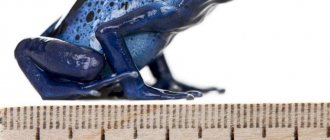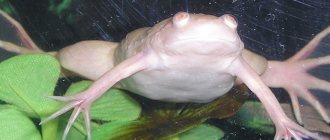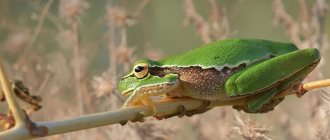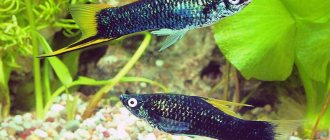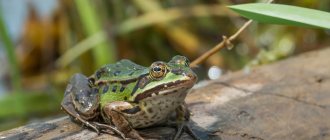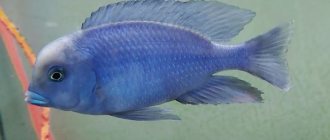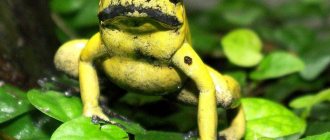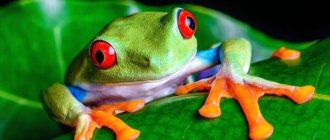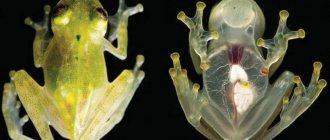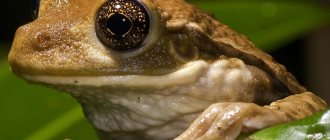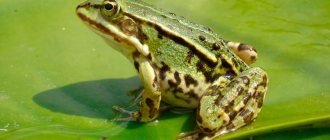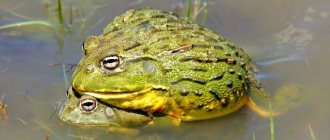Blue dart frog (Dendrobates azureus). (Image credit: Getty Images)
Poison dart frogs are small, brightly colored amphibians native to the tropical forests of Central and South America. They are members of the poison dart frog family (Dendrobatidae), and there are more than 175 known species, according to the San Francisco Zoo. According to the Rainforest Alliance, dart frogs are tiny, measuring between 2.5 and 5 centimeters in length, and, unlike many other amphibians, are diurnal, meaning they are active during the daytime. (, )
Poison dart frogs secrete toxins from their skin, which were traditionally used to make poisoned arrowheads and spears. For example, according to the American Museum of Natural History, the indigenous people of Embera and Noanam in western Colombia used the skin of the terrible leaf climber (Phyllobates terribilis) to shoot darts from a blowpipe for hundreds of years. ()
Darter frogs come in a variety of vibrant colors, which is why they are sometimes called "rainforest jewels." The bright colors of these frogs warn predators that they are poisonous and should be avoided. This survival mechanism is called aposematism. Some species of poison dart frogs also use their colors and patterns as camouflage. For example, the spotted poison dart frog (Dendrobates tinctorius) uses its bright yellow and black patterns to blend into its natural habitat. ()
The huge variety of colors among poison dart frog species may be the result of the frogs' ancestors splitting up about 10,000 years ago when what is now Panama was flooded, leading to the frogs becoming isolated in different places. According to the Smithsonian Institution, different populations of frogs then evolved their own colors. ()
Description
The blue dart frog is a tailless amphibian from the family Dart frog (Dendrobatidae). The subspecies are currently not studied.
The body length of the blue dart frog is 3.5-4.5 cm. Males are shorter than females by about 0.5 cm. Weight is 3-6 grams.
The size of frogs in natural conditions is 3.5-4.5 cm
Life expectancy in the wild is 7 years, in a terrarium – 10-12 years.
Terrarists often call them azureus, as well as azure poison dart frogs. The species is listed in the International Red Book.
Features of feeding
Dart frogs feed on live food. Moreover, it should be taken into account that the small size of the frogs’ mouth allows them to absorb only small food, no more than 3 mm (and some subspecies 1.5-2 mm). An ideal food option for poison dart frogs would be mites, spiders, tubifex flies, midges, fruit flies, aphids, bloodworms, dwarf woodlice, and insect larvae.
In principle, these amphibians are not picky about food. The only thing that is strictly contraindicated to offer them as food is zoophobes and mealyworms.
Dart frogs are fed 2 times throughout the day, in the morning and evening hours.
But a certain amount of live food should be within free access at all times.
For these purposes, you should place a small container with substrate in the terrarium, into which you should then start a Drosophila culture. The midge begins to grow and multiply, move in space, and lay eggs. Thus, if desired, the poison dart frog can exercise its innate hunting instincts and obtain nutritious food.
To prepare a high-quality substrate at home, you will need to combine oatmeal, sugar and raisins taken in equal proportions and mix thoroughly. The resulting mixture will need to be put on low heat and, stirring constantly, cook until the mass acquires a homogeneous mushy consistency. After this, add yeast to the substrate and give it the opportunity to cool and brew before adding fruit flies.
History of the breed
In the late 60s, researchers discovered a blue frog in tropical rainforests. The bright shade stood out against the general background. Because of its poisonous properties, the natives named the frog okopipi - “poison arrow frog”.
Scientists suggest that the Azureus survived the Ice Age only thanks to cryosleep. Maybe for this reason they have an “icy” color.
The species was first described in 1797 by French zoologist Frederic Cuvier.
Ranitomeya reticulatus
Native to Peru, this frog has a mild venom that can cause health problems in humans and can kill some animals. Like other poisonous frogs, these beautiful little creatures require special food to produce their poison. In this case, the “raw material” of poison for them is a poisonous ant. The frog stores poison in the skin glands and releases it as needed. Most often this happens in case of danger, when some predator is about to eat the frog.
Habitat
The habitat of the blue dart frog is a small area of the Sipaliwini River in South America. This site is located in the south of Suriname and borders Brazil and French Guiana.
Frogs live in the rainforests of South and Central America
Azureus prefer tropical rain forests with rocky soil at altitudes up to 400 m above sea level. They live in dense thickets or under piles of fallen leaves near lakes or puddles. The temperature there during the day ranges from 22° to 27°C, and at night - 20°C.
Due to its very small range, Dendrobates azureus is on the verge of extinction. The main reason is deforestation by surrounding residents.
Dangerous frog-monkey
Phyllomedusa bicolor is a very large frog belonging to the tree frog family. Distributed in tropical forests of South America. The upper part of the amphibian’s body is colored light green, while the abdomen can be cream, light yellow or white. The interesting way Phyllomedusa bicolor moves along tree branches makes it very similar to a monkey or chameleon, which is how this amphibian earned its second nickname - monkey frog, or monkey frog.
The way Phyllomedusa bicolor moves along tree branches makes it very similar to a monkey.
Local residents idolize this amphibian, believing that the poisonous substance secreted by its skin can cure any disease. Thus, the aborigines believe that the venom of phyllomedusa, which has entered the human body, is capable of driving away bad energy, thereby restoring luck, stamina and lost male sexual qualities. Toxic mucus is often used to heal snake bites, as well as to treat yellow fever, malaria, etc.
The poison of a frog is obtained in a very interesting way: it is stretched by its legs (in an X shape), and then spit on its back 3-4 times, thereby irritating the phyllomedusa, which immediately begins to secrete the necessary secretion. Next, the poison is collected with a wooden spatula, and the amphibian is released into the wild.
The aborigines believe that the venom of the phyllomedusa, which has entered the human body, is capable of driving away bad energy.
The method of using toxic mucus is also quite unusual: several small burns are applied to the aborigine’s right forearm with coal from a fire, after which these wounds are generously smeared with the resulting substance. The toxic effect manifests itself almost immediately: the heartbeat increases, blood pressure rises, then dizziness, nausea and vomiting begin. Some people lose consciousness. After about 30-40 minutes, the effect of the poison ends, and the subjects return to normal, after which they joyfully and cheerfully go about their business.
Behavior
Blue dart frogs in the wild coexist on land in mixed groups of up to 60 individuals. They lead a daily lifestyle. They walk almost all day, alternately moving their paws, and less often jump on the forest floor in search of food.
Dart frogs lead an active daily lifestyle
Males protect the areas occupied by their “harem”. They use sounds to inform opponents about this. And if their territory is encroached upon, they furiously try to push the invader out of it.
Their fights are similar to freestyle wrestling. The male, who is defeated, bows his head to the ground. It happens that fights end in the death of an opponent due to broken limbs.
Epipedobates tricolor
These frogs are very small, but are one of the most deadly amphibians. They can kill not only large animals, but also humans, so no one would think of playing with them. Frogs are endangered, so they can rarely be found even in their homeland - in the forests of Ecuador. To save these frogs and increase their numbers, researchers are trying to breed them in captivity. Preserving them is also important from a medical point of view: the poison of these frogs is 200 times stronger than morphine and is an excellent pain reliever.
Poisonous or not
The venom of the blue dart frog in nature is not as strong as that of the terrible leaf climber, one of the representatives of the Dendrobatidae family.
The Tiriyo Indian tribes from the tropical forests of the Sipaliwini savannah smear arrows with the poisonous secretion of Azureus when they hunt small animals.
Under natural conditions, frogs accumulate poison by eating poisonous ants. It is released from a huge number of glands when the skin of an amphibian is touched. The poisonous secretion protects it from fungi and bacteria, as well as from enemies in natural conditions.
Tree frog family
Dart frogs are a family of amphibians, the majority of species of which are recognized as the most poisonous frogs on the planet. Amphibians are distinguished by their small size (only from 12 to 25 mm) and weight of about 2 g. Frogs of this genus are characterized by luxurious colors of their body. Blue, lemon, yellow-black, bright red, orange are just some of the shades that dart frogs can be painted in.
Darter frogs are recognized as the most poisonous frogs in the world
The sounds made by these amphibians are not at all similar to the usual croaking; rather, they resemble the singing of a cricket or an exotic bird. Dart frogs spend a significant part of their lives on the leaves and branches of trees, hunting for small insects. Small suction cups located on the toes of their paws help them climb trunks. Thanks to this feature, the frog, like a rock climber, can overcome any vertical surface. Unlike most amphibians, dart frogs swim very poorly, and in general they do not like water so much that they even lay their eggs on leaves and branches.
These frogs move not by jumping, but by regular steps. In case of danger, they do not run away, but fall into a kind of coma, but more often they show retaliatory aggression, boldly jumping on the enemy.
The most poisonous representatives of dart frogs include:
- Terrible leaf climber (or yellow frog) - a small amphibian, the length of which reaches only 2−4 cm. The amphibian received its second name due to the rich yellow color of the body. It lives in the jungles of southwestern Colombia and is considered the deadliest frog in the whole world. The skin of the terrible leaf climber is completely covered with poisonous mucus, the basis of which is a powerful toxic substance called batrachotoxin. This poison, even with minimal contact with the skin of any living creature, causes death.
Blue dart frog - a blue frog with dark spots, quite poisonous - The blue dart frog is a very cute frog, the body of which is colored bright blue with black splashes. Distributed in Suriname, as well as on the border of French Guiana and Brazil. The amphibian is less poisonous than the previous representative, but its toxicity is also quite strong.
- The spotted dart frog is a gorgeous frog that has many subspecies with different variations of body colors. Amphibian venom that accidentally enters the blood of a person or animal can cause cardiac arrest.
- The charming leaf climber is another representative of the dangerous poison dart frog family, but not as toxic as the previous species. Lives in Central America. It is painted black with longitudinal stripes of bright orange, turquoise or pale yellow.
Diseases
Dart frogs are rather gentle creatures, and therefore, when kept in terrariums, they are often susceptible to diseases such as:
- dropsy,
- intestinal obstruction,
- pneumonia;
- blood poisoning;
- infectious pathologies;
- mycosis;
- rotting of bone and cartilage tissue;
- salmonellosis.
Many of these diseases are difficult to treat and therefore deadly. Experts and veterinarians recommend strictly following the regimen and diet of azure dart frogs, as well as the basic conditions for keeping pets, non-compliance with which often causes diseases.
Be sure to contact your veterinarian if you notice any symptoms of the disease.
If alarming symptoms are detected in an amphibian, you should immediately contact a veterinarian
Breeding at home
No matter how strange it may sound, modern exotic lovers are increasingly choosing poisonous amphibians as pets. Which is not at all surprising, because huge terrariums with colorful frogs sitting among lush vegetation are not only pleasing to the eye, but also resemble a piece of the jungle.
Modern exotic lovers are increasingly choosing poisonous amphibians as pets.
And, most importantly, keeping such an amphibian at home is absolutely safe, since in an artificial environment it completely loses its poisonous qualities. This is primarily affected by changes in the diet and living conditions of the amphibian.
The most popular terrarium frogs today are dart frogs. The main advantages of these amphibians:
- easy care;
- the diversity and beauty of the frog;
- small sizes;
- Dart frogs are completely comfortable at room temperature;
- even same-sex individuals get along well in the same terrarium;
- have interesting behavior.
Terrarium for an amphibian
Dart frogs are kept in horizontal terrariums with moderate humidity and good ventilation. The dimensions of such a “house” must first of all be selected based on the size of the terrarium vegetation, which these frogs absolutely need. For example, 2-3 pairs of individuals will feel great on an area measuring 60 by 60 cm with a wall height of about 50-70 cm.
Medium or coarse gravel can be used as soil. It is very important that the stones are constantly slightly moistened, so they must be sprayed with settled water once a day.
Medium or coarse gravel can be used as soil for frogs.
Room temperature from + 22 to + 27 °C is perfect for dart frogs, but at night it can be lowered to +18 °C. Such conditions are quite sufficient for the normal life of both amphibians and terrarium plants. Since poison dart frogs are diurnal amphibians, special attention should be paid to lighting: frogs should be provided with good light for 12 hours.
In addition, amphibians vitally need ultraviolet light, so it is very important that the terrarium is equipped with such a device. In no case should you use special heating lamps designed for reptiles (especially desert lizards and turtles), since in strong light the delicate skin of amphibians simply burns.
Amphibians vitally need ultraviolet light, so it is very important that the terrarium is equipped
Low varieties with large leaves, such as tradescantia and various representatives of bromeliads, are well suited for vegetation. A thick piece of driftwood or a small part of a tree trunk is also required. A constant supply of fresh water is extremely important, which is recommended to be kept in a coconut shell.
Nutrition and reproduction
Experienced breeders traditionally feed poison dart frogs with fruit flies, the favorite delicacy of these frogs. However, a novice owner of amphibians may have some difficulties with such “food” (flies have the not very pleasant feature of scattering throughout the apartment), so at the initial stage the frogs can be fed with caterpillar larvae or springtails.
The transformation of a tadpole into a frog is a long process that will take 2-3 months.
Dart frogs reach sexual maturity at about one year of age. After fertilization, females lay a very small number of eggs (only 3-5 pieces) in various shelters. After approximately 20-25 days, small tadpoles appear and are immediately transferred to a small plastic container with clean water. The young are fed with the usual mixture for fry of aquarium fish. The transformation of a tadpole into a frog is a rather long process, which will take 2-3 months.
Thus, even very dangerous and deadly frogs can turn into cute apartment pets, delighting their owner every day with their funny behavior and beauty.
https://youtube.com/watch?v=wpWei7ryjAQ
Price and where to buy
Due to the small population, it is not very easy to acquire poison dart frog. You are unlikely to find it in a regular pet store. But it is possible to order on a specialized website. It is important to contact a trusted seller.
The price will depend on the age of the dart frog and the regional location of the buyer. You can buy a baby blue dart frog for about 2000-2500 rubles. A female up to 1 year old can be bought for 5,000 rubles.
Blue dart frogs are spectacular, bright, unusual frogs that will decorate any terrarium.
Dart frogs are beautiful and unusual frogs that will become a worthy decoration for any terrarium.
Such beauties can be given names, because it is easy to distinguish them thanks to the individuality of color. Given the right conditions, these amazing amphibians will delight and amuse the owner for many years.
Are you interested in the blue dart frog? Or maybe you kept such a pet in an aquarium? Share your opinion and experience in the comments.
Notes[edit | edit code]
- Ananyeva N. B., Borkin L. Ya., Darevsky I. S., Orlov N. L. Five-language dictionary of animal names. Amphibians and reptiles. Latin, Russian, English, German, French. / under the general editorship of academician. V. E. Sokolova. - M.: Rus. lang., 1988. - 560 p. — 10,500 copies. — ISBN 5-200-00232-X
- ↑ a b Family Short-headed (Brachycephalidae) reports Biological Encyclopedia
- ↑ a b “Dart frogs (amphibians)” in the Great Soviet Encyclopedia
- ↑ a b c d e f g h i d Darrell, 2001
- ↑ a b c d Silverstone, 1975
- ↑ a b c d Hamlett, 2002
- ↑ a b c Cloudsley-Thompson, 1999
- ↑ a b Denver Zoological Foundation, 2000.
- ↑ a b Goin, Goin, Zag, 1978
- ↑ a b c Oregon Zoo, 2002
- ↑ a b Sandmeyer, 2003
- Blake and Sherriff, 2003
- ↑ a b c Honolulu Zoo, 2003
- National Aquarium in Baltimore, 2003
| Sample: ·· Varieties of spotted poison dart frogs (lat. Dendrobates tinctorius var.) | |
| Blue dart frog "Azurus" (lat. Dendrobates azureus) • "Orange giant" poison dart frog (lat. Dendrobates tinctorius 'Giant Orange') • "Alanis" poison dart frog (lat. Dendrobates tinctorius 'Alanis') • "Sipalivini green poison dart frog" (lat. Dendrobates tinctorius 'Green Sipaliwini' • Dendrobates tinctorius 'Blue Sipaliwini' • Dendrobates tinctorius 'Inferalanis' • Brazilian cobalt dart frog (Dendrobates tinctorius 'Brazilian') Cobalt') • dart frog "Oyapock" (lat. Dendrobates tinctorius 'Oyapock') • dart frog "Citronella" (lat. Dendrobates tinctorius 'Citronella') • dart frog "Patricia" (lat. Dendrobates tinctorius 'Patricia') • dart frog "Cobalt of the French Guyana" (lat. Dendrobates tinctorius 'French Guiana Cobalt') • poison dart frog "Blue Powder" (lat. Dendrobates tinctorius 'Powderblue') • poison dart frog "Lawa" (lat. Dendrobates tinctorius 'Lawa') • poison dart frog "Regina" (lat. Dendrobates tinctorius 'Regina') • poison dart frog "New river" (lat. Dendrobates tinctorius 'New river') • "Yellow-backed poison dart frog" (lat. Dendrobates tinctorius 'Yellowback') • "Suriname cobalt dart frog" (lat. Dendrobates tinctorius 'Surinam Cobalt') | |
| ∘ ∘ ∘ | |
Singing
Tenacious paws with suction cups, bright colors, a long sticky tongue and excellent dexterity are the characteristics of tree frogs. How else can you determine that you are dealing with a tree frog? The clear “voice” of the amphibian will help with this. The fact is that in her throat there is a resonator with an unusual structure. At the same time, in other species of frogs it is located on the sides of the head. Thanks to this feature, the tree frog sings loudly and loudly, thereby notifying everyone around about the arrival of spring.
At those moments when amphibians sing, the skin on their neck resembles a convex ball. The sounds produced during this process are often compared to the quack of ducklings. Males are considered the best artists among representatives of this species. Their jaw skin is golden in color. Singing is also used to attract females. Representatives of each species make special sounds, so only relatives respond to the call. Mating occurs in water. First, the female lays the eggs, and then the male fertilizes them. Soon the tree frog tadpoles emerge. In 50 - 100 days they turn into adults, and after two years they reach sexual maturity.
Characteristics
Most often, tree frogs are brightly colored. The standard color is a green back with emerald tints, and a milky belly. Along the sides there is a stripe, which can be either black or gray-brown, or stand out as a bright spot on a plain body.
In fact, the color directly depends on what type of poison dart frog we are talking about. There are individuals with bright blue, acid yellow and even spotted bodies. Amphibians acquire colors with age. Tadpoles are born inconspicuously brown. Color may vary depending on environmental conditions. For example, if it gets colder, the tree frog's back will become darker.
The tree frog received the name “tree nymph” for its unusual slenderness and elegance. The amphibian lives in the dense crown of plants, in the shade of bushes. In any case, the tree frog lives near bodies of water. The tree nymph is a small amphibian, most often its body length is only 5–7 cm, but some representatives reach a length of 40 cm. They are considered record holders of their kind. Males are significantly smaller in size than females.
Since frogs are cold-blooded creatures, their body temperature directly depends on environmental conditions. As soon as the air temperature drops to a critical level, tree frogs burrow underground and enter a kind of hibernation, or a state of suspended animation. Some representatives of tree nymphs are capable of spending 7 years without water, burying themselves in the desert sands. These include the Australian frog.
